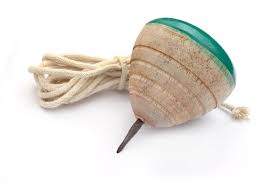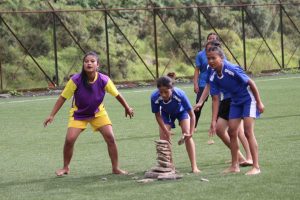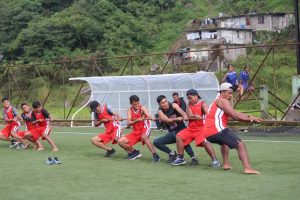Indigenous games are recreational activities that originated from a particular cultural group, community or people. These games are different from mainstream sports, which are regulated by international federations and have fixed rules. Indigenous games do not have internationally regulated rules for implementation, local organisers determine these according to the customs of the local participants. Thus creating many versions of the same group. Indigenous or traditional games in Meghalaya are an integral part of the tribal communities upholding their culture and way of life. They preserve age-old traditions and stories of the communities. Indigenous games have an origin, which is the story behind the birth of the game.
Many of these practices formed a close association with their livelihood. However, with the advent of modern science and technology such practices took a step back back in the community lives of the tribals. Indigenous sports have been played with fervour and enthusiasm for centuries in Meghalaya. Some have, with time, lost its relevance and significance. The history of games in the subcontinent is very ancient with its origin tracking back to 2000-1000 BC. According to Guinness World Records, polo’s origins in Manipur can be traced to around 3100 BC, when it was played as Sagol Kangjei. Besides, a number of leading games have had its origin in Indian states. Kabaddi in Tamil Nadu and Kho Kho in Maharashtra are such examples.
Some of the prominent indigenous games that have had its times of popularity in the state include Mawpoiñ, Pynshad Latom, Mawdot, Hai-iu, Tan tyllai among many more. Amongst the Garos Roong Sea, Resu Dena, Wapong Sala were very popular games right from centuries. Reflecting on the origins of these games before National Sports Day makes for a relevant issue.
Delving deep into Meghalaya’s rich history of traditional practices passed on to the three major tribal communities, namely the Khasi, Garo and Jaintia, for generations, Sunday Shillong dialogues with District Sports Officer of South West Khasi Hills, Damang Syngkon (DS) revisiting the possibility of reviving these sports. The South Asian Games Gold medal winner in karate (1999) and a four-time national champion, Syngkon gives an insight into how the government is fulfilling its role to promote and preserve these traditional games. Excerpts of the interview:
SS: Indigenous games have lost their significance today among the youth. What steps are the traditional bodies and the government authorities taking to promote and preserve them?
DS: While it is true that a lot of the traditional games have lost their significance with the modern generation of children, traditional games like Mawpoiñ and Rongbiria (traditional archery) are still being played or organised in Meghalaya.
Mawpoiń is one of the few traditional sports that has retained popularity in Meghalaya and generates excitement due to its basic and nature of the game. This game, however, has many versions/interpretations that are played in and around the state and similar versions of this game are also known to have been played elsewhere in the country. Hence, a need arises to have common rules and regulations formulated so as to facilitate the formal and proper regulation of this game during competitions.
SS: Are any of these games officially organised anywhere in the state?
DS: For Mawpoiñ, huge credits should be given to the Seng Khasi who organise competitions annually, as part of their sporting and cultural event called “Aiom Leh Kmen” over the last 50 years. It was from these annual competitions, organised by the Seng Khasi, that the formal rules and regulations were initially drafted. These rules have been formally submitted to the Directorate of Sports & Youth Affairs to streamline the conduct of these games
SS: Are there any prospects of including these sports in the Meghalaya Games?
DS: Mawpoiñ was featured as a demonstration game during the North East Games, 2010 in Shillong, Meghalaya. As of today, the Directorate of Sports & Youth Affairs has highlighted the importance of promoting and popularising indigenous games through its schemes and therefore Mawpoiñ and other traditional Garo Games competitions are now held regularly in the different districts and also an awareness of the formal rules and regulations of the games is growing among the youths and the participants. Mawpoiñ still has a long way to go before it finds its place in the Meghalaya Games. The mindset of the people will have to shift from one where Mawpoiñ is just a common old game, to one where people can practise and seriously compete in a sporting discipline. With the established rules and regulations in place as well as its growing popularity, we hope that Mawpoiñ will one day make the transition from a common game to a popular sport.
SS: Will South West Khasi Hills witness something special on National Sports Day?
DS: Yes. The Office of the District Sports Officer, South West Khasi Hills will be conducting the 2nd Edition of the Inter School Mawpoiñ Competition as part of the National Sports Day Celebrations where 330 students and 33 schools have already registered for participation.
SS: Have you ever played any of these traditional games yourself?
DS: I have participated in several Mawpoiñ competitions as a child, and today I am motivated to organise and promote these competitions.
SS: Why do you think people today have shifted from traditional games to modern ones?
DS: In my opinion, people deviating from traditional games to modern ones is inevitable as most of the traditional games lack coherent rules and regulations, are largely unorganised and have variations from one region/area to another. Also, I can only speculate that the global appeal and professionalism of modern sports is something that everyone is drawn towards, especially children.
SS: What is the future of these games?
DS: The future of some of these traditional games looks bright provided there is intervention through proper initiatives, support and regulation of these games. Perhaps one day these games will be deemed as popular as other traditional Indian games like Kho-Kho and Kabaddi.
————-End of interview———–
The present discourse in popular culture continues to project a certain image on the kind of sports played and who plays them, therefore reviving these traditional sports might be an uphill task, also making it significant to garner wide appreciation and uphold the identity of the indigenous communities.
(Interviewed by Aneesh Chaudhuri)
Description in Box
Pynshad Latom
 Pynshad means ‘to spin’ and latom the ‘top’ so the literal meaning is top spinning. The game is about spinning the top and the player who can stop or topple the opponent’s spinning top. It is an individual game where two more compete with their spinning tops amongst each other. The top is made of wood with a protruding nail from the middle and a string of thread mostly made from jute used to twirl the top from above. The game is a popular one especially amongst the rural populace even today. A circle is drawn for spinning the top with the motive to protect the top by pulling it away from others but ensuring it’s within the circle or else the player is penalised. The game has slowly lost its relevance. It used to be a fun recreational game for the young children. (Vikaspedia)
Pynshad means ‘to spin’ and latom the ‘top’ so the literal meaning is top spinning. The game is about spinning the top and the player who can stop or topple the opponent’s spinning top. It is an individual game where two more compete with their spinning tops amongst each other. The top is made of wood with a protruding nail from the middle and a string of thread mostly made from jute used to twirl the top from above. The game is a popular one especially amongst the rural populace even today. A circle is drawn for spinning the top with the motive to protect the top by pulling it away from others but ensuring it’s within the circle or else the player is penalised. The game has slowly lost its relevance. It used to be a fun recreational game for the young children. (Vikaspedia)
Mawpoiñ
 A popular game, still relevant in both rural and urban areas. A glimpse of the game can be occasionally seen in many localities across the city. The game is popular amongst all age groups both men and women. The name Mawpoiñ has two meanings, ‘Maw’ meaning stone and ‘poiñ’ means arrangement of the stones. These stones are arranged preferably according to their sizes, with the biggest forming the base, almost forming a pyramid shape. The game consists of two teams beginning with a toss to begin the game. The team that wins the toss begins the game by throwing the ball towards the arranged stones. The opponent team will then collect the ball and throw it at the opponents preventing them from arranging the stones. If the ball hits the person he or she is no longer eligible to play. The game can end in two ways when all the stones are rearranged or when all players have been hit by the ball. (Singh and Singh, 2012*)
A popular game, still relevant in both rural and urban areas. A glimpse of the game can be occasionally seen in many localities across the city. The game is popular amongst all age groups both men and women. The name Mawpoiñ has two meanings, ‘Maw’ meaning stone and ‘poiñ’ means arrangement of the stones. These stones are arranged preferably according to their sizes, with the biggest forming the base, almost forming a pyramid shape. The game consists of two teams beginning with a toss to begin the game. The team that wins the toss begins the game by throwing the ball towards the arranged stones. The opponent team will then collect the ball and throw it at the opponents preventing them from arranging the stones. If the ball hits the person he or she is no longer eligible to play. The game can end in two ways when all the stones are rearranged or when all players have been hit by the ball. (Singh and Singh, 2012*)
Tan Tyllai
This game is universal. It is the famous tug of war or pulling of the rope that is played worldwide. Amongst the indigenous communities, the game has a twist as it is played with a song in the background. Before the game begins captains are chosen from the two teams who act as the defenders of their respective teams, who then have two leaders joining their hands upward in an arch and start singing the game’s song, followed by other players joining the arch. Once the song is over, the leaders will catch the last person who is stuck in between them. The song will be sung for many rounds till all the players have chosen sides. This process will go on till all the players get the chance to choose sides. Then the tug of war begins. They will either pull each other’s hands or rope. (Vikaspedia)
joining the arch. Once the song is over, the leaders will catch the last person who is stuck in between them. The song will be sung for many rounds till all the players have chosen sides. This process will go on till all the players get the chance to choose sides. Then the tug of war begins. They will either pull each other’s hands or rope. (Vikaspedia)
Wapong Sala
A popular game seen during the Wangala Festival. It is an old game popular amongst the Garos. The game is played by two players at a time. The motive of the game is to put the strength of a player to the test. The two players competing against each other sit facing each other on the ground with their legs stretched out, between them there is bamboo to support their legs. When the game starts both the players pull each other holding each other’s hand. The player who succeeds in pulling his rival from the ground wins the game. (Singh and Singh, 2012*)
Roong Dea
This sport is similar to modern day weightlifting which demonstrates the strength of the participant. A smooth round stone weighing near about 100 kgs or more is placed among the spectators who gather from the village including neighbouring villages. The game is open to all and anybody from amongst the spectators can try his luck in picking the stone in turns and the player who lifts the highest is the winner and the strongest. This is famous during the Wangala festival of Garos. (Singh and Singh, 2012*)
(*Traditional Sports and Martial Arts of Meghalaya, Dr. S Ranjit Singh and N. Sunderlal Singh; International Journal of Innovative Research & Development 2012)



